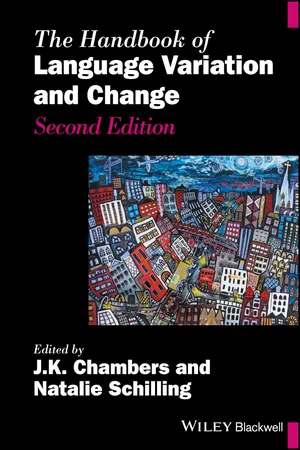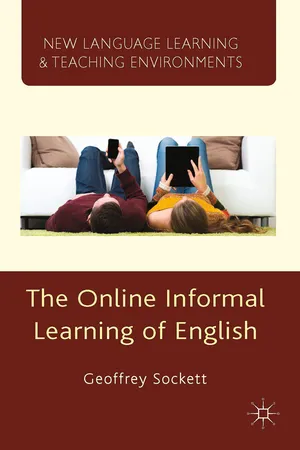Languages & Linguistics
Informal Language
Informal language refers to the casual, everyday language used in relaxed or familiar settings, often characterized by colloquial expressions, slang, and non-standard grammar. It is typically used in conversations among friends, family, and peers, and may vary widely across different social groups and regions. Informal language is contrasted with formal language, which is used in more formal or professional settings.
Written by Perlego with AI-assistance
Related key terms
3 Key excerpts on "Informal Language"
- eBook - ePub
- J. K. Chambers, Natalie Schilling, J. K. Chambers, Natalie Schilling(Authors)
- 2013(Publication Date)
- Wiley-Blackwell(Publisher)
Studying Language Variation An Informal Epistemology J.K. ChambersSocieties can obviously exist without language, as witness the social organizations of carpenter ants, honey bees and great apes. But languages cannot exist without societies. Language is quintessentially social, and throughout recorded history, normal human beings have shown unbounded capabilities for social intercourse, conversational interaction, repartee, self-expression, and tale-telling both real and imagined, all governed by intricate sets of conventions normally beneath consciousness.Before language existed, our hominoid ancestors organized bands for food-gathering and habitats for sheltering their young; and probably, by analogy with the great apes, not much more. In the absence of language, finding daily sustenance and preventing yourself and your young from becoming sustenance for others are pretty much full-time activities. Since survival and propagation can be achieved in the absence of language, it was obviously not survival and propagation that called language into being. Rather, language is the tool for virtually every human aspiration beyond plain survival and propagation.Sociolinguistics is the study of the social uses of language, in its many guises. In this chapter, I sketch an informal epistemology of sociolinguistics by outlining its historic development as a linguistic discipline (in Section 1), the persistence of social evaluation in language matters (in Section 2), the place of sociolinguistics among the linguistic sciences (in Section 3), and its relation to communicative competence (in Section 4) and to communicative intelligence (in Section 5).1 Sociolinguistics as a Discipline
Studying the social uses of language proceeds mainly by observing language use in natural social settings and categorizing the linguistic variants according to their social distribution. The most productive studies have emanated from determining the social evaluation of linguistic variants. These are also the areas most susceptible to scientific methods such as hypothesis-formulation, logical inference, and statistical testing. - eBook - ePub
- G. Sockett(Author)
- 2014(Publication Date)
- Palgrave Macmillan(Publisher)
In this chapter, OILE will be situated in the context of a number of existing paradigms, namely informal learning, computer assisted language learning, learner autonomy, complex dynamic systems, input hypothesis and intertextuality. This eclectic range of theoretical positions reflects the interdisciplinary nature of the research presented in this book and is necessary to encompass the sociocultural, cognitive, didactic and linguistic factors which interact together in such informal learning.2.1 What is informal learning?Use of the term “informal learning” to describe the way in which exposure to English outside the classroom may lead to acquisition of the language, has a number of limits, which should be presented at the outset, since other terms may present advantages over it or may at least be considered equally valid.“Informal” relates to settings in which the exposure takes place and should not be confused with the language register of the same name, although the extent to which informal learning leads to the acquisition of the informal register shall be discussed later. Since the work in this book moves from understanding what learners are doing in their free time to understanding how this impacts acquisition, the term “incidental acquisition” may also have been used since it focuses on the non-deliberate aspect of the phenomenon, although reducing emphasis on the context in which the acquisition takes place, as Ellis (1994) and others have pointed out, incidental acquisition is central to most types of language learning, including learning in formal contexts.The learning/acquisition debate is one which is familiar to students of language learning and teaching and it will become apparent in the research presented here that there are few, if any, organised learning activities at work in OILE. The term is, therefore, to be understood in a more general sense as leading to knowledge of the language, rather than as in opposition to acquisition. - eBook - ePub
Language Learning and Leisure
Informal Language Learning in the Digital Age
- Denyze Toffoli, Geoffrey Sockett, Meryl Kusyk, Denyze Toffoli, Geoffrey Sockett, Meryl Kusyk(Authors)
- 2023(Publication Date)
- De Gruyter Mouton(Publisher)
→Kusyk, Meryl. 2017. The development of complexity, accuracy & fluency in L2 written production through informal participation in online activities. CALICO Journal 34 (1). 75–96. a , bKusyk, Meryl. 2020. Informal English learning in France. In Mark Dressman & Randall William Sadler (eds.), The Handbook of Informal Language Learning, 333–348. Hoboken/Chichester: Wiley-Blackwell. a , bLai, Chun, Xiao Hu & Boning Lyu. 2018. Understanding the nature of learners’ out-of-class language learning experience with technology. Computer Assisted Language Learning 31(1–2). 114–143. →Lee, Ju Seong. 2019. Quantity and diversity of informal digital learning of English. Language Learning & Technology 23(1). 114–126. a , bLee, Ju Seong & Mark Dressman. 2018. When IDLE hands make an English workshop: Informal digital learning of English and language proficiency. TESOL Quarterly 52(2). 435–445. →Li, Shuai. 2019. Cognitive approaches in L2 pragmatics research. In Naoko Taguchi (ed.), The Routledge Handbook of Second Language Acquisition and Pragmatics, 113–127. Abingdon: Routledge. →Liao, Silvie. 2009. Variation in the use of discourse markers by Chinese teaching assistants in the U.S. Journal of Pragmatics 41(7). 1313–1328. a , b , cLindgren, Eva & Carmen Muñoz. 2013. The influence of exposure, parents, and linguistic distance on young European learners’ foreign language comprehension. International Journal of Multilingualism 10(1). 105–129. →Liu, Binmei. 2016. Effect of L2 exposure: From a perspective of discourse markers. Applied Linguistics Review 7(1). 73–98. a , b , cLutzky, Ursula & Matt Gee. 2018. I just found your blog: The pragmatics of initiating comments on blog posts. Journal of Pragmatics 129. 173–184. →Magliacane, Annarita. 2020. Erasmus students in an Irish study abroad context: A longitudinal analysis of the use of well and like. Study Abroad Research in Second Language Acquisition and International Education 5(1). 92–120. →
Index pages curate the most relevant extracts from our library of academic textbooks. They’ve been created using an in-house natural language model (NLM), each adding context and meaning to key research topics.


